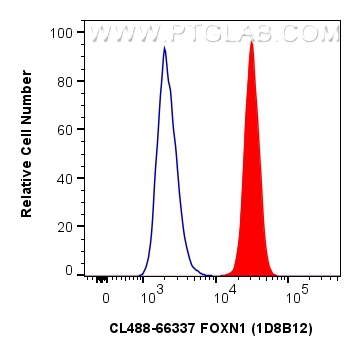验证数据展示
经过测试的应用
| Positive FC (Intra) detected in | A549 cells |
推荐稀释比
| 应用 | 推荐稀释比 |
|---|---|
| Flow Cytometry (FC) (INTRA) | FC (INTRA) : 0.40 ug per 10^6 cells in a 100 µl suspension |
| It is recommended that this reagent should be titrated in each testing system to obtain optimal results. | |
| Sample-dependent, Check data in validation data gallery. | |
产品信息
CL488-66337 targets FOXN1 in FC (Intra) applications and shows reactivity with human samples.
| 经测试应用 | FC (Intra) Application Description |
| 经测试反应性 | human |
| 免疫原 |
CatNo: Ag18207 Product name: Recombinant human FOXN1 protein Source: e coli.-derived, PGEX-4T Tag: GST Domain: 261-648 aa of BC146539 Sequence: STDGHQPLFPKPIYSYSILIFMALKNSKTGSLPVSEIYNFMTEHFPYFKTAPDGWKNSVRHNLSLNKCFEKVENKSGSSSRKGCLWALNPAKIDKMQEELQKWKRKDPIAVRKSMAKPEELDSLIGDKREKLGSPLLGCPPPGLSGSGPIRPLAPPAGLSPPLHSLHPAPGPIPGKNPLQDLLMGHTPSCYGQTYLHLSPGLAPPGPPQPLFPQPDGHLELRAQPGTPQDSPLPAHTPPSHSAKLLAEPSPARTMHDTLLPDGDLGTDLDAINPSLTDFDFQGNLWEQLKDDSLALDPLVLVTSSPTSSSMPPPQPPPHCFPPGPCLTETGSGAGDLAAPGSGGSGALGDLHLTTLYSAFMELEPTPPTAPAGPSVYLSPSSKPVALA 种属同源性预测 |
| 宿主/亚型 | Mouse / IgG1 |
| 抗体类别 | Monoclonal |
| 产品类型 | Antibody |
| 全称 | forkhead box N1 |
| 别名 | Winged-helix transcription factor nude, WHN, RONU, Forkhead box protein N1, forkhead box N1 |
| 计算分子量 | 648 aa, 69 kDa |
| 观测分子量 | 60 kDa |
| GenBank蛋白编号 | BC146539 |
| 基因名称 | FOXN1 |
| Gene ID (NCBI) | 8456 |
| RRID | AB_3084235 |
| 偶联类型 | CoraLite® Plus 488 Fluorescent Dye |
| 最大激发/发射波长 | 493 nm / 522 nm |
| 形式 | Liquid |
| 纯化方式 | Protein G purification |
| UNIPROT ID | O15353 |
| 储存缓冲液 | PBS with 50% glycerol, 0.05% Proclin300, 0.5% BSA, pH 7.3. |
| 储存条件 | Store at -20°C. Avoid exposure to light. Stable for one year after shipment. Aliquoting is unnecessary for -20oC storage. |
背景介绍
FOXN1, also named as Forkhead box protein N1, is a 648 amino acid protein, which contains 1 fork-head DNA-binding domain and localizes in the nucleus. FOXN1 as transcriptional regulator regulates the development, differentiation, and function of thymic epithelial cells (TECs) both in the prenatal and postnatal thymus. FOXN1 acts as a master regulator of the TECs lineage development and is required from the onset of differentiation in progenitor TECs in the developing fetus to the final differentiation steps through which TECs mature to acquire their full functionality.


